ISSN ONLINE(2319-8753)PRINT(2347-6710)
ISSN ONLINE(2319-8753)PRINT(2347-6710)
Vaibhav B. Chavan1, Vikas N. Nimbalkar1, Abhishek P. Jaiswal2
|
| Related article at Pubmed, Scholar Google |
Visit for more related articles at International Journal of Innovative Research in Science, Engineering and Technology
The study aims to evaluate the economic significance of the Hollow Structural Sections (HSS) in contrast with open sections. This study was carried out to determine the percentage economy achieved using Hollow Structural Sections (HSS) so as to understand the importance of cost effectiveness. The technique used in order to achieve the objective included the comparison of different profiles for various combinations of height and material cross-section for given span and loading conditions. The analysis and design phase of the project was performed using STAAD PRO V8i. The sample results of STAAD analysis were validated with the results of Manual analysis
Keywords |
| Hollow Structural Sections, Open sections, STAAD PRO V8i, Utility factor, Joint efficiency. |
INTRODUCTION |
| In many situations lighter steel structure were invariably prepare to the heavier alternatives such as reinforce concrete or priestess concrete. The main advantages of steel structure were its intrinsic strength, prefabrication and quicker transportability to the work site and faster erection. Steel structures can easily dismantle without loss to the integrity of the original structure. Most structural steel units were prefabricated in a workshop with a superior quality control compared to In-situ construction. Tolerance specified in the Indian Standard codes for steel structural component during the fabrication erection were small compared to similar reinforced concrete structures. Steel also plays an important role in composite construction in conjunction with reinforced and priestess concrete structure. With the development of steel as a construction material, the varieties of steel sections were also increased. Among these sections, the Hollow structural sections (HSS) or Structural hollow sections were the most reliable one. Due to their outstanding features, the application of these sections in present commercial market has been tremendously increased. |
II. ORIGIN OF HOLLOW STRUCTURAL SECTIONS |
| The history of hollow structural section was very old and interesting because of their shape. The origin of Hollow structural section was connected with the origin and development of steel only. Basically, the concept of hollow structural section was developed by day to day lifestyle, first the concept of steel and then after the use of steel for different purposes. The concept of circle was firstly originated and then after square, rectangle etc. Initially, they were used for different purposes such as wheels of bullock carts, for different shapes of pot etc. First the conventional steels were used for different structures and then after, on identifying the benefits of different shapes such as circular, square, rectangular etc. The hollow sections were developed, experimented and used for construction purpose. The excellent properties of the tubular shape have been recognized for a long time i.e .from ancient time. In 18th century, the first production methods for seamless and welded circular hollow sections were developed. In 1886, the “Mannesmann Brothers” developed the skew roll piercing process. |
III. OBJECTIVES AND STUDY |
| The following are some of the prime objective of this study: 1. To compare analysis and design of the truss in industrial structures of different span and profiles using hollow structural sections and open sections. |
| 2. To compute the most efficient sections in terms of economy. To study on rate of economy achieved with variations in material of trusses. 3. To determine the utilization percentage of individual member using HSS and open sections. 4. To obtain an aesthetically sound structure as compared to conventional structures. 5. To identify the geometrical advantages of HSS as compared to open section. The profiles and cross sections of trusses with various combinations of span and heights were developed and study was carried out such that the result of study represents the objective of the work. |
IV. CLASSIFICATION OF HOLLOW STRUCTURAL SECTION |
| HSS was classification in the following types as given below: A. Welded tube B. Seamless tube In welded tubes the hot rolled or cold form steel sheets were rolled in to tubes and welded along its length. The welded tubes were classified into following: I. Hot finished welded (HFW) II. Electric resistance welded (ERW) III. Cold drawn electric resistance welded (CEW) IV. Oxy acetylene welded (OAW) The descriptions of topics mentioned above were not in scope of project work. The seamless steel tubes were joint less continuous tubes of some length. These can be made by subtracting a required shape from solid steel section by applying pressure at elastic stage of steel. They were also classified as follows: I. Hot finished seamless (HFS) II. Cold drawn seamless (CDS) |
V. MECHANICAL AND GEOMETRICAL PROPERTIES OF HOLLOW SECTIONS |
| Hollow sections as steel profiles were not only in competition with concrete, but also they may be substitute for other steel profiles due to their superiority with regard to strength and stability. The mechanical and geometrical properties of the hollow section indicate under which loadings, a saving in material can be obtained. a) Mechanical Properties: Average Yield Strength The average yield strength fya may be determined from full size section tests or as follows: |
| fya = fyb + (k. n. t2/A).(fu-fyb) |
| where, fyb, fu is the specified tensile yield strength and ultimate tensile strength of the basic material (N/mm2) t is the material thickness (mm) A is the gross cross-section area (mm2) k is the coefficient depending on the type of forming (k = 7 for cold rolling) n is the number of 900 bends in the section with an internal radius <5t (fractions of 900 bends should be counted fractions of n) fya should not exceed fu or 1,2 fyb The increase in yield strength due to cold working should not be utilized for members which were annealed* or subject to heating over a long length with a high heat input after forming, which may produce softening. Basic Material: Basic material was the flat hot rolled sheet material out of which sections are made by cold forming. Stress relief annealing at more than 5800 or for over one hour may lead to deterioration of the mechanical properties. b) Geometrical properties: The selection of hollow sections depends on their geometrical properties and thus on the member resistances for particular loading cases. Tolerances were in general lower than for open sections. c) Tension loading: |
| The design strength of a member under a tensile loading depends on the cross-sectional area and the design yield stress, and was independent of the sectional shape. In principle, there was no advantage or disadvantage in using hollow sections from the point of view of the amount of material required. d) Compression Loading: The buckling of a concentrically compressed column was, historically speaking, the oldest problem of stability and was readily investigated by Euler’s and later by many other researchers. At present, the buckling design of a steel element under compression was performed by using the so called “Buckling Curves” of their respective countries. They are based on many extensive experimental and theoretical investigations, which in particular, take mechanical (for e.g. residual stress and yield stress distribution) and geometrical (for e.g. linear deviation) imperfection in the members into account. |
 |
| A detailed discussion can be done on the differences between buckling curves used in codes around the world. Both design methods, allowable stress design and limit state design, can be covered. For ultimate limit state design, multiple buckling curves were mostly used (as for example, Euro code 3 with a0, a, b, c curves, similarly in Australia and Canada). Other standards adopt a single buckling curve, presumably due to fact that emphasis was placed on simplicity. Differences up to 15% can be observed between the various buckling curves in the regions of medium slenderness (λ). The selection of the buckling curve (i.e. a, b, c) depends on the cross section type. This was mainly based on the residual stresses occurring due to different manufacturing processes. Fig.2. shows the curves for hollow sections Where, Fyb = Yield strength of the basic (not cold-formed) material Fya = Yield strength of the material after coldforming Most open sections fall under curves “b” and “c”. Consequently, for the case of buckling, the use of hotformed hollow sections generally provides a considerable saving in mass. Fig.1. shows a comparison between the required mass of open and hollow sections for a given load. The overall buckling behavior of hollow sections improves with increasing diameter or width to wall thickness ratio. However, this improvement was limited by local buckling. To prevent local buckling d/t or b/t were given in table below for plastic as well as elastic design. |
 |
| can offer other advantages in lattice girders. Due to the torsional and bending stiffness of the members in combination with certain joint fixity, the effective buckling length of compressive embers can be reduced. Laterally unsupported bottom chords of lattice girder have reduced buckling length due to the improved torsional and bending stiffness of the tubular members. These factors make the use of hollow sections in girders even more favorable. e) Torsion: Hollow sections, especially CHS have the most effective cross-section for resisting torsional moments, because the material was uniformly distributed about the polar axis. A comparison of open and hollow sections of nearly identical mass shows that the torsional constant of hollow sections was 200 to 300 times larger than that of open sections. f) Bending: In general, the Universal Beam and Universal Column sections were more economical under bending (Imax larger than for hollow sections). Only in those cases in which the design stress in open sections was largely reduced by lateral buckling, can hollow sections offer an advantage. It can be shown by calculations that for circular hollow sections and for rectangular hollow sections having b/h > 0.25, which were normally used, lateral instability was not critical. Hollow sections used for elements subjected to bending can be more economically calculated using plastic design. For the use of compact sections in plastic design, the limiting d/t or b/t values were given in Table II. g) Fatigue: The fatigue behavior of hollow section joints was influenced largely by the geometrical stress or strain concentration factor (SCF or SNCF). A structure made of hollow sections should be designed and detailed so that the SCF or SNCF was low. In this way, economical design of hollow section joints was possible even under fatigue conditions, particularly when assessed in terms of low load coefficients for wind and wave, reduced mass and corrosion protection. |
VI. GRADE OR STRENGTH OF STEEL USED FOR HSS |
| As per the IS-4923:1997 and IS-1161:1998; |
 |
VII. REASONS FOR USING HOLLOW STRUCTURAL SECTIONS |
| 1. Structural hollow sections have excellent static properties, not only with regard to buckling and torsion, but also in Overall design of members they can offer economic advantages compared to open section. 2. The closed shape and the smooth change over from one section to another at joints reduce the costs of corrosion protection. It was possible to change the strength by varying the wall thickness or by filling the section with concrete without changing the outside dimensions. 3. The inner space gives possibilities for the combination of the strength function with others, e.g. Fire protection, heating, ventilation, etc. The rational application of hollow sections will, in general, lead to clean, spacious, functional structures which appeal to architects. Circular hollow section often offer a decisive advantage with regard to structure exposed to air or water flow. In other situations, square and rectangular hollow sections were favored because they use simple connections with straight end cuts of the connecting members. To reduce the number of joints and to obtain a better joint strength, a Warren-type truss was preferred to a Pratt type truss. 4. Although the unit material cost of hollow sections was higher than for open sections, a proper use will lead to economical designs. Good design in hollow section does not mean “change the member of an open section design to hollow section”, but means making use of their specific properties right from other beginning. |
VIII. OTHER ASPECTS OF APPLICATION OF HOLLOW SECTIONS |
| Hollow sections present a striking advantage for use in building structures exposed to fluid currents, i.e. Air or water. There drag coefficients were much lower than those of ordinary sections with sharp edges as shown in Fig. 3. The drag coefficients for wind loading on circular and rectangular hollow sections have been determined in the last twenty years by a series of tests. Based on these tests, the following conclusions can be derived: For all sharp edged profiles, open or closed (R/D<0,025), the drag coefficient Cw was independent of Reynold's number Re = V.D/υ Where, V is the wind velocity; D is the width of the cross section; υ is the kinematic viscosity. The values were higher than those for hollow sections with rounded corners. Drag coefficient Cw for rectangular hollow sections with rounded corners, especially for circular hollow sections, was strongly dependent on Re .For Re lower than a certain number (subcritical), Cw remains constant and was quite large. After exceeding this Re-value, Cw drops steeply. With increasing Re, Cw then rises slowly, but it never attains the initial value (see Fig.4). |
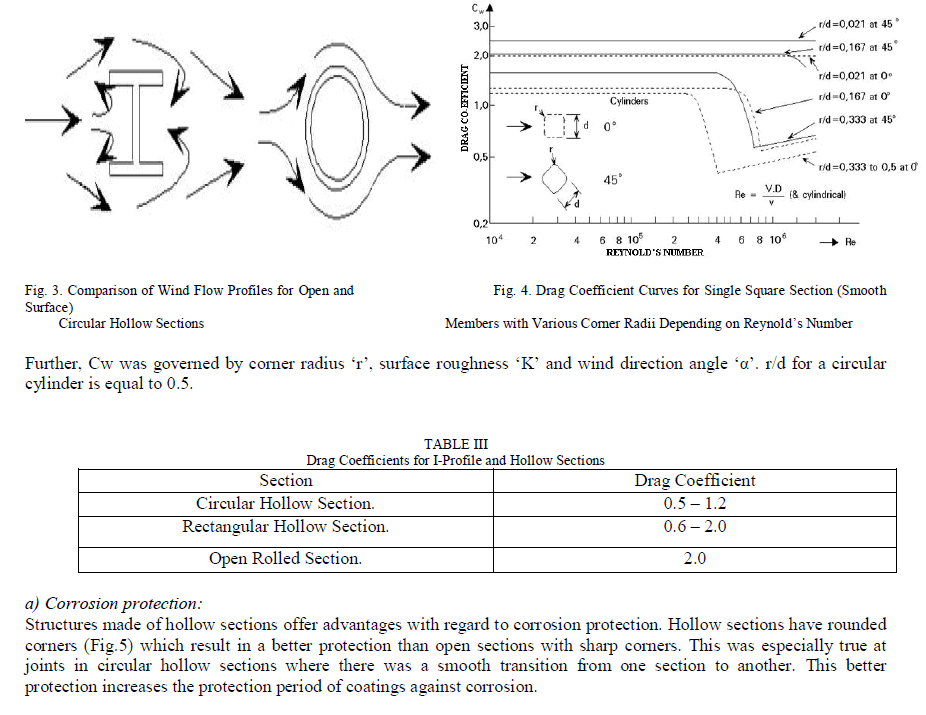 |
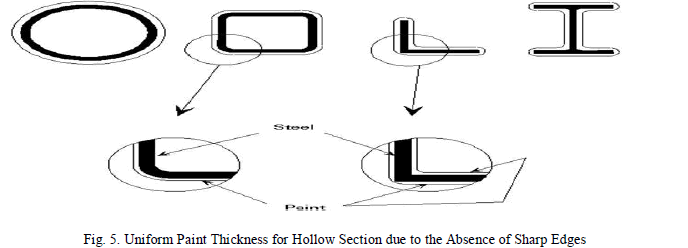 |
| Structures designed in hollow sections have a 20 to 50% smaller surface to be protected than comparable structures made using open sections. Many investigations have been carried out to assess the likelihood of internal corrosion. These investigations, carried out in various countries, show that internal corrosion does not occur in sealed hollow sections. Even in hollow sections which were not perfectly sealed, internal corrosion was limited. If there was concern about condensation in an imperfectly sealed hollow section, a drainage hole can be made at a point where water cannot enter by gravity. b) Use of internal void: The internal void in hollow sections can be used to advantage in various ways, e.g. to increase the bearing resistance by filling with concrete, or to provide fire protection. In addition, the heating or ventilation system was sometimes incorporated into hollow section columns. The possibilities of using the internal space were briefly described below. c) Concrete filling: If the commonly available wall thicknesses were not sufficient to meet the required load bearing resistance, the hollow section can be filled with concrete. For example, it may be preferable in buildings to have the same external dimensions for the columns on every floor. At the top floor, the smallest wall thickness can be chosen, and the wall thickness can be increased with increasing load for lower floors. If the hollow section with the largest available wall thickness was not sufficient for the ground floor, the hollow section can be filled with concrete to increase the load bearing resistance. A very important reason for using concrete-filled hollow sections was that the columns can be relatively slender. d) Fire protection by water circulation and concrete-filling: One of the modern methods for fire protection of buildings was to use water-filled hollow section columns. The columns were interconnected with a water storage tank. Under fire conditions, the water circulates by convection, keeping the steel temperature below the critical value of 450áõÃâC. This system has economical advantage when applied to buildings with more than 8 storey’s. If the water flow was adequate, the resulting fire resistance time was virtually unlimited. In order to prevent freezing, potassium carbonate (K2CO3) was added to the water. Potassium nitrate was used as an inhibitor against corrosion. Concrete filling of hollow sections contributes not only to an increase in loadbearing resistance, but it also improves fire resistance duration. The extensive test projects carried out by CIDECT and ECSC have shown that reinforced concrete-filled hollow section columns without any external fire protection like plaster, asbestos and Vermiculite panels or in tumescent paint, can attain a fire life of even 2 hours depending on the cross-section ratio of the steel and concrete, reinforcement percentage of the concrete and the applied load. Related calculation diagrams were available. e) Heating and ventilation: The inner voids of hollow sections were sometimes used for air and water circulation for heating and ventilation of buildings. Many examples in offices and schools show the excellent combination of the strength function of hollow section columns with the integration of the heating or ventilation system. This system offers maximization of floor area through elimination of heat exchangers, a uniform provision of warmth and a combined protection against fire. |
| f) Other possibilities: Sometimes hollow section chords of lattice girder bridges were used for conveying fluids (Pipe Bridge). The internal space can also be used for prestressing a hollow section. Sometimes in buildings the rain water downpipes go through the hollow section columns or in other cases electrical wiring was located in the columns. g) Aesthetics: A rational use of hollow sections leads in general to structures which were cleaner and more spacious. Hollow sections can provide slender aesthetic columns, with variable section properties but flush external dimensions. Due to their torsional rigidity, hollow sections have specific advantages in folded structures, V-type girders, etc. The latticed construction, which was often made of hollow sections directly connected to one another without any stiffener or gusset plate, was often preferred by architects for structures with visible steel elements. However, it was difficult to express aesthetic features in economic comparisons. Sometimes hollow sections were used only because of aesthetic appeal, whilst at other times appearance was less important |
IX. METHODOLOGY |
| The modern construction techniques and materials have brought a revolutionary change in the construction industry. The development in construction materials raised the possibility of achieving additional economy. The economy of trusses in industrial shed got adversely affected with the use of these different materials. An extensive study on rate of economy achieved with variation in materials of trusses was proposed in this Study. The functioning of the project depends upon the effective planning and management of the proposed work. This generates the importance of distinguishing the work into smaller units which were well controlled. This project comprises of several such units which were broadly classified in the following perspective. 1) Design hypothesis 2) Participants 3) Resources 4) Procedure 1 Design hypothesis: a) Theoretical considerations b) Practical Considerations 2 Participants: For the effective performance of any operation, resources were the most basic essentials. Among the resources, participants act as the key players in execution of operation. They define the object or model on which the analysis was carried out. The criterion for selection of participants (models) depends upon several factors. This article elaborates the selection process of participants (Truss profile and geometry as in this case) used in the final analysis phase of the project. The criteria of selection employed were described in the following points: a) Choice of profile b) Choice of section c) Choice geometric parameters |
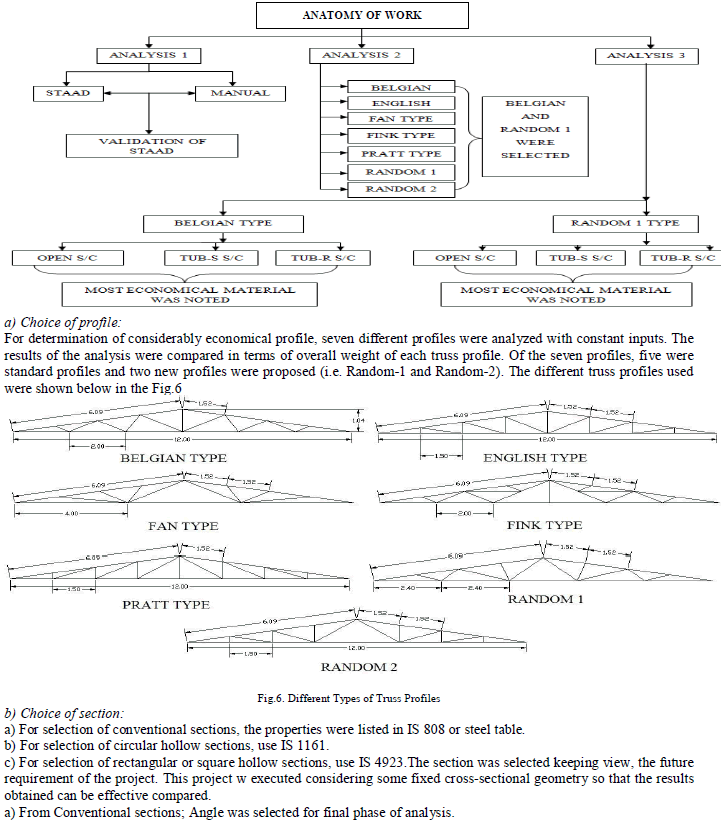 1 1 |
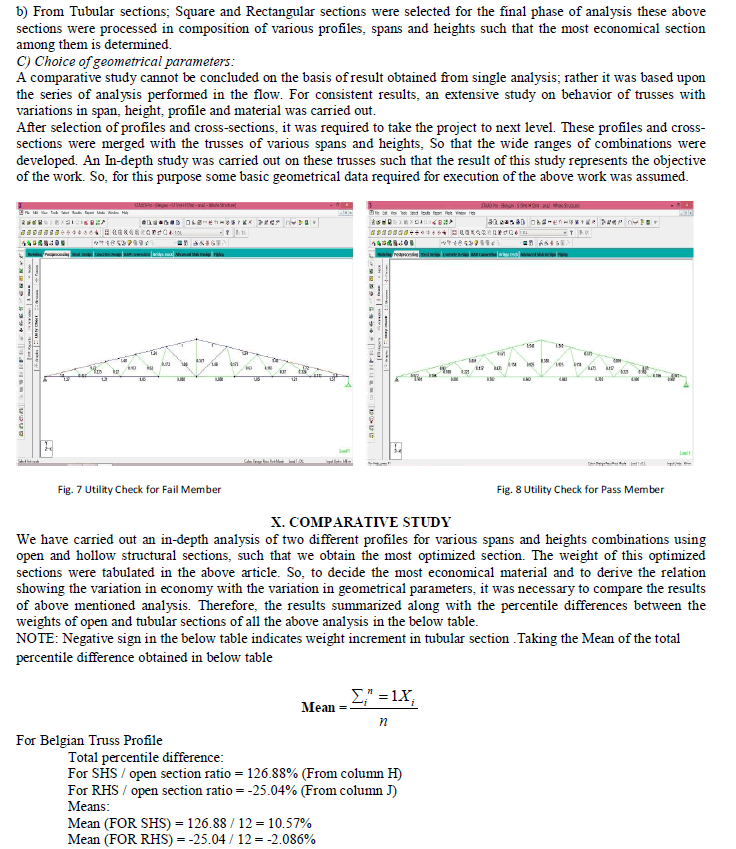 |
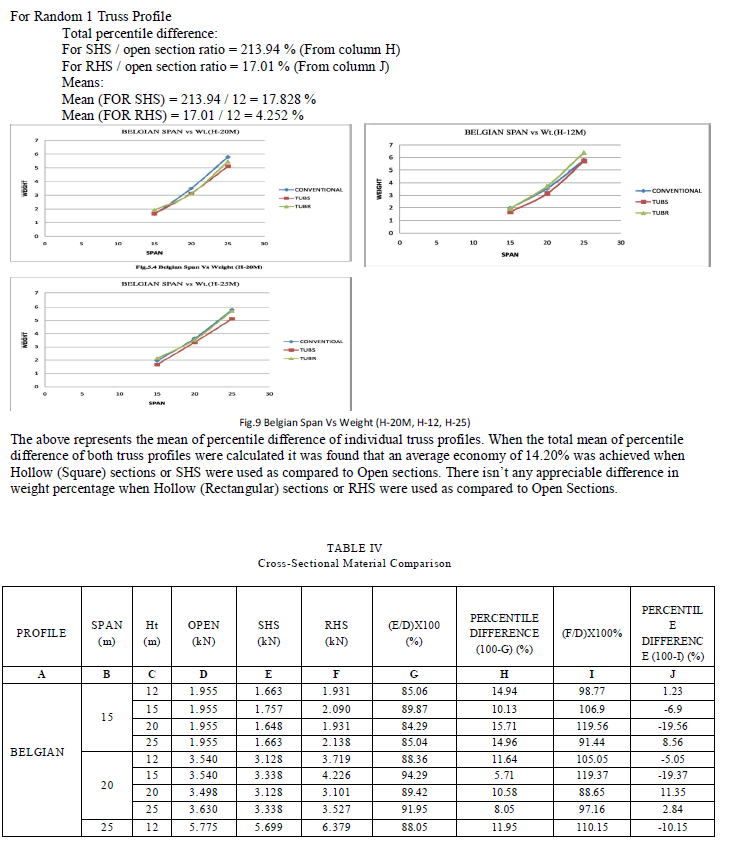 |
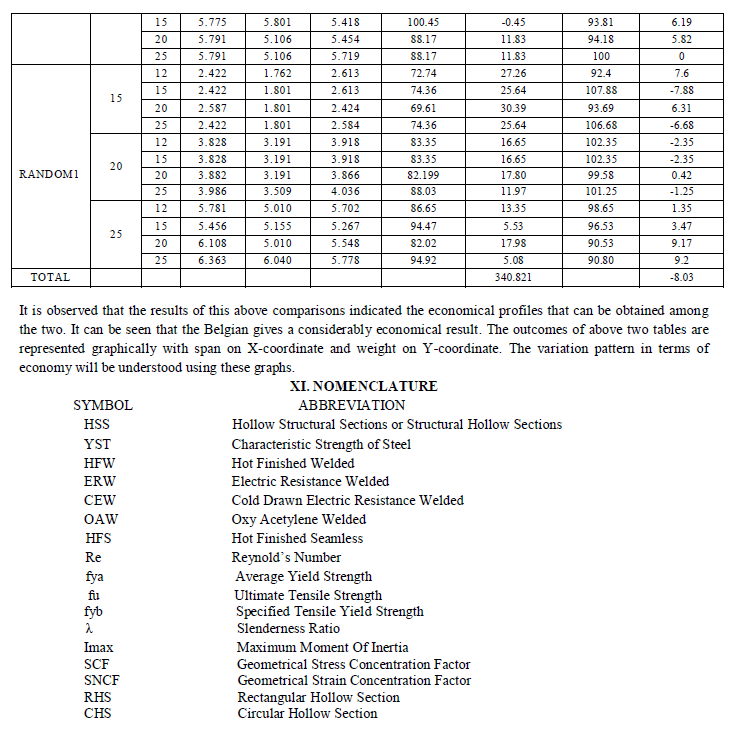 |
XII. CONCLUSION |
| After comparison of results obtained from all the analysis of trusses, it is concluded that: 1) For Belgian truss profile; the mean economy achieved for Square Hollow Section (SHS) and Rectangular Hollow Section (RHS) was 10.57% and -2.08% respectively when compared to Open Section. (NOTE: Negative sign indicates uneconomical section) |
| 2) For Random-1 truss profile; the mean economy achieved for SHS and RHS was 17.82% and 4.25% respectively when compared to open section. 3) The overall mean economy achieved for SHS was 14.20% with respect to Open section whereas; RHS was 0.33% uneconomical with respect to open section. 4) The economy of SHS when compared to open section decreases with increase in span. This ranges from 27.26% to 5.08% for span of 15 to 25m respectively. 5) It was observed that Belgian profile was more cost effective when compared to Random- 1. |
ACKNOWLEDGEMENT |
| I am greatly indebted forever to my guide Dr. A.G. Dahake, Asso. Prof. Shreeyash College of Engineering and Technology, Aurangabad for his continuous encouragement, support, ideas, most constructive suggestions, valuable advice and confidence in me. I sincerely thank to Prof. A.P. Jaiswal, Asst. Prof. Shreeyash College of Engineering and Technology Engineering, Aurangabad for their encouragement and kind support and stimulating advice. |
References |
|